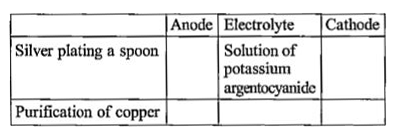Copy and complete the following table.
Only one free surfaceSolidSpontaneous and rapid diffusion
To complete the table based on the information provided in the video transcript, we will fill in the characteristics of solids, liquids, and gases regarding their free surfaces and diffusion properties.
1. Identify the States of Matter: We have three states of matter to consider: Solid, Liquid, and Gas.
2. Free Surfaces:
- Solid: Solids have more than one free surface (e.g., a cube has 6 surfaces).
- Liquid: Liquids have only one free surface (the top surface).
- Gas: Gases have no free surfaces (they expand to fill their container).
3. Diffusion:
- Solid: Solids do not show diffusion.
- Liquid: Some liquids show diffusion (e.g., alcohol in water), but not all.
- Gas: Gases undergo spontaneous and rapid diffusion.
Completed Table:
| State of Matter | Free Surface | Diffusion |
|------------------|------------------------|-------------------------------|
| Solid | More free surfaces | No diffusion |
| Liquid | Only one free surface | Some diffusion |
| Gas | No free surfaces | Spontaneous and rapid diffusion|
- Solid: Solids have more than one free surface (e.g., a cube has 6 surfaces).
- Liquid: Liquids have only one free surface (the top surface).
- Gas: Gases have no free surfaces (they expand to fill their container).
- Solid: Solids do not show diffusion.
- Liquid: Some liquids show diffusion (e.g., alcohol in water), but not all.
- Gas: Gases undergo spontaneous and rapid diffusion.
|------------------|------------------------|-------------------------------|
| Solid | More free surfaces | No diffusion |
| Liquid | Only one free surface | Some diffusion |
| Gas | No free surfaces | Spontaneous and rapid diffusion|
Topper's Solved these Questions
- BOOK - PEARSON IIT JEE FOUNDATIONCHAPTER - CLASSIFICATION OF MATTEREXERCISE - ESSAY TYPE QUESTIONS8videos
CLASSIFICATION OF MATTER
- BOOK - PEARSON IIT JEE FOUNDATIONCHAPTER - CLASSIFICATION OF MATTEREXERCISE - CONCEPT APPLICATION LEVEL-110videos
CLASSIFICATION OF MATTER
- BOOK - PEARSON IIT JEE FOUNDATIONCHAPTER - CLASSIFICATION OF MATTEREXERCISE - VERY SHORT-ANSWER TYPE QUESTIONS20videos
CLASSIFICATION OF MATTER
- BOOK - PEARSON IIT JEE FOUNDATIONCHAPTER - CLASSIFICATION OF MATTEREXERCISE - ASSESSMENT TEST (TEST-2)9videos
CLASSIFICATION OF MATTER
- BOOK - PEARSON IIT JEE FOUNDATIONCHAPTER - MOCK TESTEXERCISE - EXERCISE25videos
MOCK TEST
Similar Questions
Knowledge Check
- Question 1 - Select One
Which of the following surfaces would result in diffuse reflection?
APlane mirrorBStill water in a lakeCClean, polished steel plateDWooden bark of a tree - Question 2 - Select One
Surfaces which cause diffuse reflection
APlane mirrorBStill water in a lakeCClean, polished steel plateDWooden bark of a tree - Question 3 - Select One
(A) An electrochemical cell can be set-up only if the redox reaction is spontaneous.
(R) A reaction is spontaneous if free energy change is negative.Aif both assertion and reason are true and the reason is the correct explanation of the assertion.BIf both assertion and reason are true but reason is not the correct explanation of the assertion.CIf assertion is true but reason is falseDIf the assertion and reason both are false.
Copy and complete the following table which refers to two practical applications of electrolysis.
 View Solution
View SolutionA solid that has only one vertex is
View SolutionGive one example of the diffusion of a solid in another solid.
View SolutionThe angle which the free surface of a liquid filled in a container will make with horizontal if the container is accelerated horizontally with acceleration g√3 is
View SolutionA simple table is that table which shows only one characteristic of the data.
View Solution



